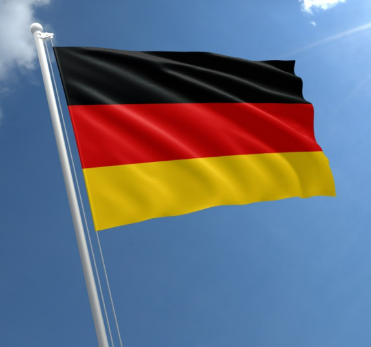
Tourists can explore the top 10 historical sites in Germany, which offer a rich blend of culture, architecture, and fascinating history.
Here are some details about the top 10 historical sites in Germany:
1. Brandenburg Gate in Berlin:
2. Neuschwanstein Castle in Bavaria:
3. Cologne Cathedral in Cologne:
4. Berlin Wall Memorial:
5. Heidelberg Castle in Heidelberg:
6. Rothenburg ob der Tauber:
7. Sanssouci Palace in Potsdam:
8. Nuremberg Castle in Nuremberg:
9. Dachau Concentration Camp Memorial Site:
10. The Romantic Road:
1. Brandenburg Gate in Berlin Germany:
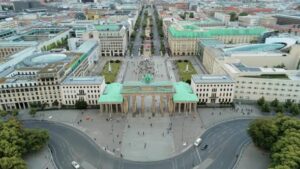
The Brandenburg Gate in Berlin, Germany is one of the historical sites and a beautiful monument, and one of the most famous landmarks of the city for tourists.
Here are some details about the Brandenburg Gate for tourists:
1. History:
The Brandenburg Gate was built in the late 18th century as a symbol of peace and unity.
It has since become a symbol of German unity and freedom, particularly after the fall of the Berlin Wall in 1989.
2. Architecture:
The Brandenburg Gate is a neoclassical triumphal arch with Doric columns and a chariot statue on top.
It stands at the entrance to the Unter den Linden boulevard in the heart of Berlin.
3. Significance:
The Brandenburg Gate has witnessed many important historical events, including Napoleon’s march through the gate, the division of Berlin during the Cold War, and the reunification of Germany in 1990.
4. Quadriga:
The Quadriga statue on top of the Brandenburg Gate depicts the goddess Victoria riding a chariot drawn by four horses.
It is a symbol of victory and has become an iconic image of Berlin.
5. Location:
The Brandenburg Gate is located near other important landmarks such as the Reichstag building, Tiergarten Park, and the Holocaust Memorial, making it a central point for tourists exploring Berlin.
6. Visiting:
Visitors can walk through the Brandenburg Gate and take photos from both sides.
It is also a popular spot for events, concerts, and celebrations, especially during New Year’s Eve and other holidays.
Overall, the Brandenburg Gate is a must-see attraction in Berlin, offering a glimpse into the city’s history and serving as a symbol of unity and freedom for Germany.
2. Neuschwanstein Castle in Bavaria Germany:
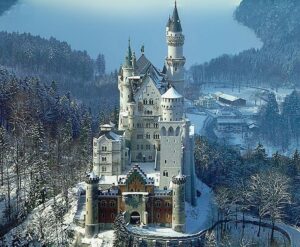
Neuschwanstein Castle, located in Bavaria, Germany, is a stunning and iconic tourist destination. Here are some details about Neuschwanstein Castle for tourists:
1. History:
Neuschwanstein Castle was commissioned by King Ludwig II of Bavaria in the 19th century and was inspired by the romanticism of medieval castles.
It is one of the most famous castles in the world and served as the inspiration for the Disney castle.
2. Architecture:
The castle’s design is a blend of Romanesque and Gothic styles, featuring ornate turrets, towers, and picturesque surroundings.
The interior of the castle is equally impressive, with lavish rooms decorated in a medieval theme.
3. Location:
Neuschwanstein Castle is situated on a hilltop overlooking the village of Hohenschwangau in Bavaria, offering breathtaking views of the surrounding Alps and lakes.
4. Tours:
Visitors can take guided tours of the castle to explore its interior, including the Throne Room, King’s Bedroom, and Hall of Singers.
Tours provide insight into the history and architecture of the castle.
5. Surroundings:
In addition to visiting the castle, tourists can enjoy hiking trails, scenic viewpoints, and nearby attractions such as Hohenschwangau Castle and the Alpsee Lake.
6. Accessibility:
Neuschwanstein Castle is accessible by car, bus, or scenic hike from the village of Hohenschwangau.
It is recommended to purchase tickets in advance, as the castle is a popular tourist destination.
Overall, Neuschwanstein Castle, Germany is one of the historical sites and a must-visit destination for tourists in Bavaria, offering a glimpse into the fairy-tale world of King Ludwig II and the beauty of the German countryside.
Known as the “Fairytale Castle,” Neuschwanstein is a stunning 19th-century palace that inspired Disney’s Sleeping Beauty Castle.
3. Cologne Cathedral in Cologne Germany:
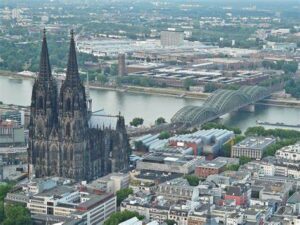
Certainly! The Cologne Cathedral, also known as Kölner Dom in German, is a magnificent Gothic masterpiece located in the heart of Cologne, Germany.
This iconic landmark is one of the most visited tourist attractions in the country, drawing millions of visitors from around the world each year.
Similarly, construction of the Cologne Cathedral began in 1248 and took over 600 years to complete, making it one of the most impressive architectural feats in Europe.
The cathedral’s towering spires, intricate facades, and stunning stained glass windows are a testament to the skill and craftsmanship of the medieval builders who worked on this monumental project.
The climb may be challenging, with over 500 steps to reach the viewing platform, but the panoramic views of the city and the Rhine River are well worth the effort.
From this vantage point, visitors can admire the intricate stonework of the cathedral up close and take in the breathtaking scenery of Cologne and its surroundings.
Generally, inside the cathedral, visitors can marvel at the stunning interior, which features ornate altars, beautiful sculptures, and a magnificent organ.
The cathedral also houses the Shrine of the Three Kings, which is said to contain the relics of the Three Wise Men.
These tours provide fascinating insights into the construction of the cathedral, its significance in German history, and the stories behind its many sculptures and artworks.
Whether you are interested in history, architecture, or simply seeking a breathtaking view of the city, the Cologne Cathedral offers a truly unforgettable experience.
Overall, the Cologne Cathedral is a must-visit attraction for anyone traveling to Cologne, offering a glimpse into centuries of history and architectural brilliance. Enjoy your visit!
4. Berlin Wall Memorial Germany:

The Berlin Wall Memorial, located in the heart of Berlin, Germany, is a poignant reminder of the division that once separated East and West Berlin during the Cold War.
This one of the historical sites serves as a powerful symbol of the struggle for freedom and unity, making it a must-visit destination for tourists seeking to understand the tumultuous past of Germany.
In addition, visitors to the memorial can explore various elements that provide insight into the history and significance of the Berlin Wall.
The Berlin Wall Memorial stretches along a 1.4-kilometer section of the former border that divided the city.
In addition, one of the key features of the memorial is the Documentation Center.
It offers a comprehensive exhibition detailing the construction of the wall, its impact on the city and its residents, and the stories of those who lived through this period of division.
In addition to the Documentation Center, visitors can also see preserved sections of the original wall and watchtowers.
They can explore other remnants of the border fortifications that once stood as barriers between East and West Berlin.
These physical remnants serve as a stark reminder of the harsh realities faced by those living on either side of the wall.
The Berlin Wall Memorial also includes the Chapel of Reconciliation, a place of reflection and remembrance for those affected by the division of Berlin.
The chapel stands on the site of a former church that was demolished during the construction of the wall, symbolizing the hope for peace and reconciliation in the aftermath of this turbulent period in German history.
5. Heidelberg Castle in Heidelberg Germany:
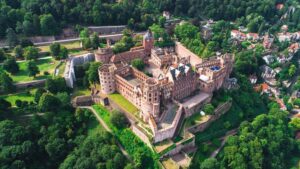
Heidelberg Castle, located majestically above the beautiful city of Heidelberg, Germany, is one of the historical sites and enchanting places that captivate tourists from all over the world.
Generally, this iconic castle, with its rich history and stunning architecture, offers visitors a glimpse into the past and a truly unforgettable experience.
Dating back to the 13th century, the Heidelberg Castle is a symbol of the region’s medieval heritage and has played a significant role in the history of Germany.
The castle’s impressive ruins, including the iconic red sandstone facade, draw visitors in with their grandeur and charm.
In the meantime, as tourists explore the castle grounds, they can marvel at the intricate details of the architecture, from the ornate Renaissance sculptures to the Gothic vaulted ceilings.
One of the highlights of a visit to Heidelberg Castle is the panoramic views it offers of the town below and the Neckar River winding through the valley.
The castle’s terraces and gardens provide the perfect vantage points to soak in the breathtaking scenery and capture memorable photos.
Surely, inside the castle, visitors can explore the various rooms and courtyards, each with its own unique story to tell.
The Great Barrel, a massive wine barrel housed in the castle’s cellar, is a particularly popular attraction, showcasing the region’s rich winemaking history.
For those interested in delving deeper into the history of the Heidelberg Castle, guided tours are available in multiple languages.
These tours offer fascinating insights into the castle’s past and the lives of the people who once inhabited it.
In conclusion, a visit to the Heidelberg Castle is a must for any tourist exploring Germany.
6. Rothenburg ob der Tauber Germany:
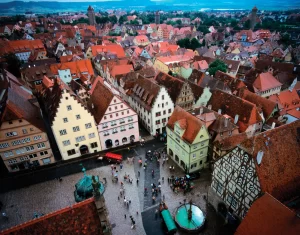
Rothenburg ob der Tauber, a charming medieval town nestled in the heart of Bavaria, Germany, is a fairy-tale destination.
It enchants tourists with well-preserved historical sites and architecture, cobblestone streets, and romantic atmosphere of Germany.
This picturesque town, often referred to as the “Jewel of the Romantic Road,” offers visitors a step back in time to the Middle Ages.
As a result, it is a popular destination for tourists seeking a unique and immersive experience.
One of the most iconic features of Rothenburg ob der Tauber is its well-preserved medieval city walls, which encircle the town and offer stunning views of the surrounding countryside.
Generally, visitors can walk along the walls and admire the picturesque rooftops, towers, and half-timbered houses that make up the town’s skyline.
The town’s Market Square, with its charming fountain and colorful buildings, is a bustling hub of activity.
Tourists can shop for souvenirs, sample local delicacies, and soak in the vibrant atmosphere.
The imposing Rothenburg Town Hall, with its impressive tower and ornate facade, is a must-see for history buffs and architecture enthusiasts.
Additionally, it offers a fascinating glimpse into the town’s rich history and architectural heritage.
The St. James Church, with its intricate Gothic architecture and stunning stained glass windows, is another highlight for visitors interested in religious history and art.
The museum’s exhibits include artifacts, paintings, and interactive displays that bring the town’s storied past to life.
Overall, a visit to Rothenburg ob der Tauber promises a magical experience for tourists, with its enchanting medieval charm, historic landmarks, and welcoming atmosphere.
Whether you are strolling along the cobblestone streets, exploring the town’s museums, or simply taking in the beauty of its architecture, Rothenburg ob der Tauber offers something for everyone.
7. Sanssouci Palace in Potsdam Germany:
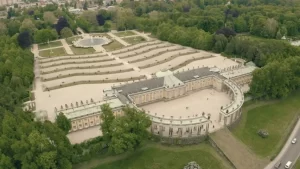
Sanssouci Palace is a stunning rococo-style palace located in Potsdam, Germany. It was built in the 18th century as a summer retreat for Frederick the Great, King of Prussia.
The palace is surrounded by beautiful gardens, vineyards, and terraces, making it a popular tourist destination.
In other words, visitors to Sanssouci Palace can explore the lavish interior rooms, including the opulent Marble Hall, the ornate Chinese Room, and the grand Picture Gallery.
The palace is filled with exquisite artwork, furniture, and decorations that showcase the wealth and taste of its royal inhabitants.
In addition to the palace, tourists can wander through the vast Sanssouci Park, one of the historical sites of Germany
The park features numerous fountains, sculptures, and manicured gardens.
The park offers breathtaking views of the palace and the surrounding countryside, making it a perfect spot for a leisurely stroll or a picnic.
Overall, Sanssouci Palace is a must-see destination for history buffs, architecture enthusiasts, and anyone looking to experience the grandeur of Prussian royalty.
The summer palace of Frederick the Great, Sanssouci is a beautiful rococo-style palace and picturesque gardens.
Frederick the Great’s summer palace, Sansuke is a beautiful Rococo-style palace and charming gardens.
8. Nuremberg Castle in Nuremberg Germany:
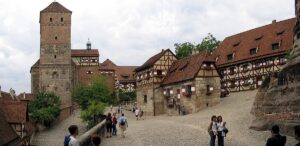
Nuremberg Castle, located in the city of Nuremberg, Germany, is a historic landmark that dates back to the Middle Ages.
In addition, the castle complex consists of several buildings, including the Imperial Castle, the Burgraves’ Castle, and the Sinwell Tower.
It has stunning views of the surrounding area, and moreover, it is perched on a ridge of sandstone that overlooks the city.
Tourists traveling to Nuremberg Kastal, Germany can find historical sites, different buildings, and courtyards, each of which has a unique construction style and historical importance.
The Imperial Castle, in particular, is a must-see attraction, as it was once the residence of the Holy Roman Emperors.
One of the highlights of a visit to Nuremberg Castle is the Deep Well, a 50-meter-deep well that provided the castle with a reliable source of water during times of siege.
Visitors can also climb to the top of the Sinwell Tower for panoramic views of the city and the surrounding countryside.
In addition to its historical significance, Nuremberg Castle is also home to several museums and exhibitions that showcase the city’s rich cultural heritage.
The castle grounds are also a popular venue for events and festivals throughout the year.
Overall, Nuremberg Castle is a must-visit destination for tourists looking to immerse themselves in the history and culture of this fascinating city.
Whether you’re interested in medieval architecture, panoramic views, or cultural exhibitions, Nuremberg Castle has something to offer for everyone.
A medieval fortress overlooking the city, Nuremberg Castle offers panoramic views and insights into the city’s history.
9. Dachau Concentration Camp Memorial Site Germany:
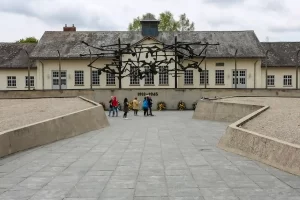
The Dachau Concentration Camp Memorial Site, located near Munich, Germany, serves as a somber reminder of the atrocities committed during the Holocaust.
As one of the first concentration camps established by the Nazis in 1933, Dachau holds a significant place in history and serves as a powerful educational tool for visitors.
In general, upon entering the memorial site, tourists are greeted by the infamous “Arbeit Macht Frei” (Work Sets You Free) gate, a chilling reminder of the camp’s dark past.
The site includes reconstructed barracks, guard towers, and crematoriums, providing a glimpse into the harsh living conditions and brutal treatment endured by prisoners.
Additionally, visitors can explore the museum on-site, which houses exhibits detailing the camp’s history, prisoners’ lives, and liberation.
Personal stories, photographs, and artifacts offer a poignant look at the human impact of the Holocaust.
The memorial site also features religious memorials, including a Jewish memorial and a Catholic chapel, providing spaces for reflection and remembrance.
The International Monument, a sculpture dedicated to the victims of Dachau, stands as a symbol of hope and remembrance.
Furthermore, guided tours are available for visitors seeking a deeper understanding of the camp’s history and significance.
Knowledgeable guides provide insight into the daily life of prisoners, the camp’s role in the Nazi regime, and the importance of remembering the past to prevent future atrocities.
Overall, the Dachau Concentration Camp Memorial Site offers a sobering and educational experience for tourists.
It serves as a poignant reminder of the horrors of the Holocaust and the importance of preserving history to ensure that such atrocities are never repeated.
10. The Romantic Road Germany:
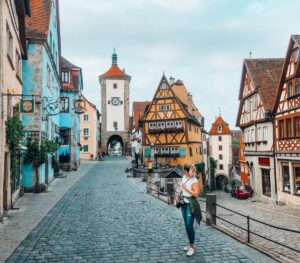
The Romantic Road is a picturesque and historic route in Germany that stretches approximately 350 kilometers from Würzburg in the north to Füssen in the south.
This iconic road takes travelers through charming towns, medieval villages, and stunning landscapes, offering a glimpse into the rich history and culture of the region.
Commencing in Würzburg, visitors can explore the stunning Würzburg Residence; furthermore, it is a UNESCO World Heritage Site renowned for its Baroque architecture and beautiful gardens.
Explore quaint towns like Rothenburg ob der Tauber on the Romantic Road, known for its medieval old town and charming houses.
That is to say, one of the highlights of the Romantic Road is the picturesque town of Dinkelsbühl, with its well-preserved city walls and historic buildings.
Nearby, the town of Nördlingen is famous for its circular medieval wall and unique geological features, making it a must-visit for history and nature enthusiasts alike.
Further south, the Romantic Road takes travelers through the picturesque region of Bavaria, where they can visit the iconic Neuschwanstein Castle, the inspiration for Disney’s Sleeping Beauty Castle.
The town of Füssen, located near the castle, is a charming destination with its colorful buildings and stunning views of the surrounding mountains.
Throughout the journey along the Romantic Road, visitors can enjoy traditional German cuisine, including hearty dishes like schnitzel and sausages, as well as delicious local wines and beers.
The road is also dotted with charming cafes, bakeries, and shops selling local handicrafts, making it a perfect destination for food and souvenir enthusiasts.
Overall, the Romantic Road offers a unique and unforgettable travel experience for tourists looking to explore the beauty and history of Germany.







